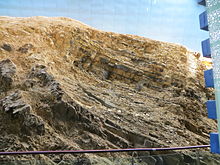Cambrian chordates
The Cambrian chordates are an extinct group of animals belonging to the phylum
The Cambrian chordates are characterised by the presence of segmented muscle blocks called myomeres and notochord, the two defining features of chordates. Before the full understanding of Cambrian fossils, chordates as members the most advanced phylum were believed to appear on Earth much later than the Cambrian. However, the better picture of Cambrian explosion in the light of Cambrian chordates, according to Stephen Jay Gould, prompted "revised views of evolution, ecology and development," and remarked: "So much for chordate uniqueness marked by slightly later evolution."[7]
Discovery

Pikaia gracilens was the first Cambrian chordate known. It was discovered by
The second Burgess shale chordate was also discovered by Walcott but left unexamined. The date of discovery was not recorded. Italian palaeontologist Alberto M. Simonetta, while working at the US National Museum of Natural History, where Walcott's collections are maintained, became the first to analyse the specimen in 1960.[18] He and Emilio Insom at the University of Camerino published the classification in 1993, giving the name Metaspriggina walcotti, an animal with unknown identity.[2] Conway Morris recovered additional specimen with which he described the species as that of chordate in 2008.[18]

In 1991,
Burgess Shale chordates
Pikaia gracilens

Pikaia gracilens was a primitive chordate having a lancelet-like body that lacked a well-defined head components and averaged about 3.8 cm in length. On each side of its head is a pair of large, antenna-like tentacles similar to those of snails.[21] There are a series of short appendages on either side of the underside of the head just after the mouth, and their exact nature or function is unknown. The pharynx is associated with six pairs of slits with tiny filaments that could be used for respiratory apparatus.[22]
A hollow tubular structure running from its anterior part of the body to the tail was earlier believed to be an indication of the presence of a
The muscle orientation and flat shaped body indicate that Pikaia was an active and free swimmer.[8] It would have swum by throwing its body into a series of S-shaped, zigzag curves, as do living eels. However, its myomere arrangement suggests that Pikaia could not be a fast swimmer.[25]
Metaspriggina walcotti

Metaspriggina Walcotti is fish-like and measures up to 6 centimetres (2.4 in) in length and 1 centimetre (0.39 in) in breadth.[26] It possesses a notochord along with seven pairs of pharyngeal bars, possibly made of cartilage. The pharyngeal bars were formed of multiple separate pairs of bones. The first two pairs are larger than the others and do not support any gills, a characteristic that suggests a distant relationship to gnathostomatans (jawed vertebrates from fish to humans).[18] It lacked fins and it had a weakly developed cranium, but possessed two well-developed upward-facing eyes with nostrils behind them. Unlike in Pikaia in which myomeres are numerous and V-shaped, the myomeres have a W-shaped configuration and are 40 in number.[26]
Maotianshan Shale chordates
Yunnanozoon lividum

Yunnanozoon lividum is small, measuring 2.5 to 4 cm long. It is described as a
An analysis in 2015 concluded that
Myllokunmingia fengjiaoa

Myllokunmingia fengjiaoa is 2.8 cm long and 0.6 cm high. It is among the oldest possible
Zhongjianichthys rostratus
Zhongjianichthys rostratus is generally regarded as an early fish, and therefore as one of the first vertebrates. It has an eel-like body, 1.1 cm in length, and covered with a thick integument. It has no visible myomeres. Its ventral fin is low and runs much of the body's length. It has reduced fins that indicates that it was mainly bottom-dwelling and did not swim much.[6][31]
Zhongxiniscus intermedius
Zhongxiniscus intermedius had a small, broad and short, fish-like body that was roughly 10 mm in length. It has S-shaped myomeres, dorsal and ventral fins. It is tentatively interpreted as an intermediate form between Cathaymyrus and two vertebrates Haikouichthys and Myllokunmingia.[32]
Haikouichthys ercaicunensis
Haikouichthys ercaicunensis looks like Myllokunmingia with which it was discovered from the same beds. The body about 2.5 cm (1 in) long and is narrower than Myllokunmingia. The head and tail are distinct at the opposite ends. There are at least six to nine probable gills. The myomeres are with rear directed chevrons in the tail. It has a long notochord along its body length.[33] It has a prominent dorsal fin with fin radials but not as well developed in those of hagfish and lampreys.[34]
References
- ^ S2CID 27671780.
- ^ ISSN 0373-4137.
- ^ S2CID 85077111.
- S2CID 85619898.
- S2CID 250380981.
- ^ ISSN 2076-3263.
- S2CID 5589793.
- ^ a b Walcott, Charles D. (1911). "Cambrian Geology and Paleontology II: No.5--Middle Cambrian Annelids" (PDF). Smithsonian Miscellaneous Collections. 57 (5): 109–144.
- ^ Simon, Conway Morris (1977). "Aspects of the Burgess Shale fauna, with particular reference to the non-arthropod component". Journal of Paleontology. 51 (Suppl 2): 7–8.
- .
- JSTOR 24965247.
- JSTOR 2096795.
- OCLC 18983518.
- ISBN 978-0-226-40319-9.
- ISSN 2076-3263.
- ^ "Worm-like creature could be humans' oldest ancestor". 2012-03-05. Retrieved 2022-09-23.
- ^ "Human's oldest ancestor found". University of Cambridge. 2012-03-06. Retrieved 2022-09-23.
- ^ S2CID 85619898.
- ^ S2CID 4343223.
- ^ S2CID 84567733.
- S2CID 86599352.
- ISBN 978-0-19-512568-9.
- PMID 26446368.
- S2CID 27671780.
- PMID 22695332.
- ^ S2CID 2850050.
- S2CID 4368647.
- ^ S2CID 250380981.
- PMID 16701387. Archived from the original(PDF) on 2008-12-17. Retrieved 2008-11-06.
- S2CID 4402854.
- S2CID 85163902.
- S2CID 84505454.
- S2CID 4401274
- PMID 15312089
